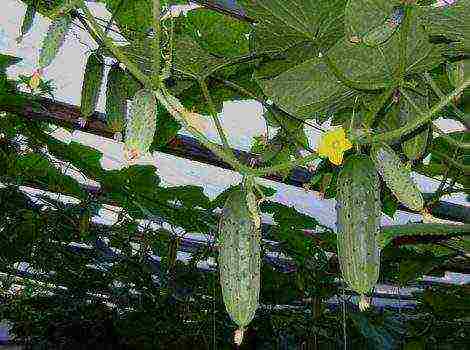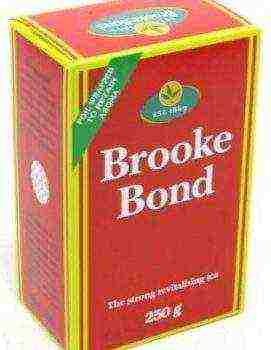Content
- 1 Description of the types and varieties of Kuril tea
- 2 Growing Kuril tea: planting and care
- 3 Description and application of Kuril tea
- 4 Kuril tea varieties: photos and description of shrubs
- 5 Breeding methods for Kuril tea
- 6 Planting shrub Kuril tea
- 7 How to care for Kuril tea and how to prune a shrub
- 8 Kuril tea
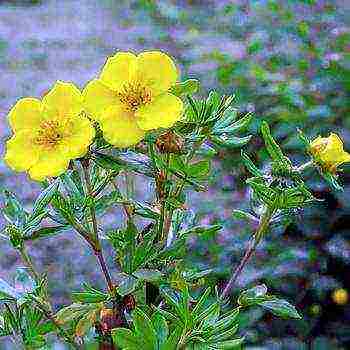 The Kuril tea plant in the conventional sense is not tea - it is just an ornamental crop of long flowering, which makes it very popular when grown in personal plots. But in ancient times, the leaves of some types of Kuril tea were dried, brewed and used as a tonic drink. This plant perfectly tolerates haircuts and is unassuming to care for.
The Kuril tea plant in the conventional sense is not tea - it is just an ornamental crop of long flowering, which makes it very popular when grown in personal plots. But in ancient times, the leaves of some types of Kuril tea were dried, brewed and used as a tonic drink. This plant perfectly tolerates haircuts and is unassuming to care for.
Description of the types and varieties of Kuril tea
Here you can find photos and descriptions of the most common types of Kuril tea.
Kuril tea (Pentaphylloides) is a plant of the Rosaceae family. Another name is five-leafed. The plant is commercially found under the name Potentilla.
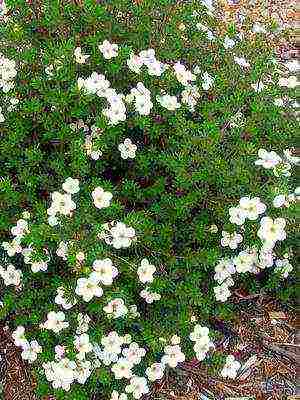
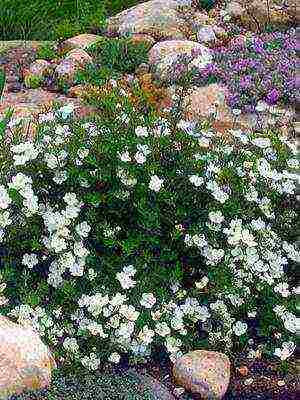
Kuril Daurian tea (P. davurica). Shrub up to 0.6 m high. Shoots are glabrous. The crown is loose, up to 1 m in diameter. The bark is gray. The leaves consist of five oblong leaves, shiny above, green, glaucous below.
As you can see in the photo, the Kuril tea plant of this type has white flowers, up to 2.5 cm in diameter, single or in small shields:
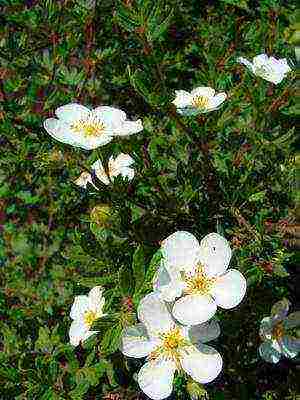

It blooms for a very long time, up to 100 days, from May to mid-September, abundantly. Winter-hardy.

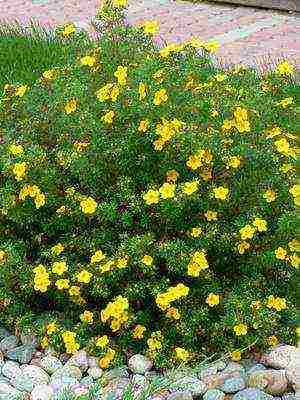
Kuril shrub tea (P. fruticosa). Grows on rocky slopes, talus, on rocks. The description of this type of Kuril tea speaks for itself - it is a deciduous shrub, about 1 m tall, with outstretched branches. The crown is spherical, dense, up to 1.5 m in diameter. The flowers are golden yellow, up to 3 cm in diameter, single or collected in small brushes. Blooms from June to August.
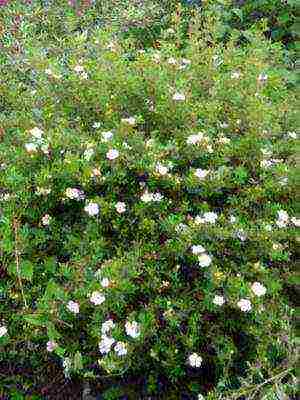

Abbotswood ("Abbotswood"). A low shrub up to 1 m in height and a slightly larger crown diameter, up to 1.3 m. It has a dense pillow-like crown. The flowers are pure white, up to 2.5 cm in diameter, single or collected in small brushes. Blooms from June to October. One of the best varieties.


"Pretty Poly" ("Pretty Polly"). Height 0.6 m, crown diameter 120 cm. Shrub with thin broad-spreading shoots, dense crown. This variety of Kuril tea has light pink flowers along the edge, dark pink towards the center, of medium size (diameter 3.5 cm). Blooms from May to September.
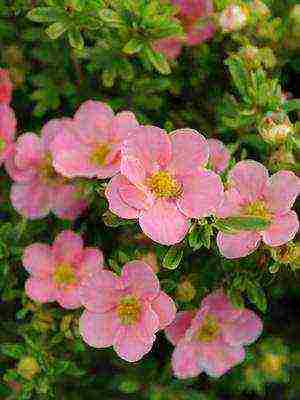

"Princess" ("Princess"). The height of the shrub is 0.8 m, the diameter of the crown is 120 cm. The crown is dense, cushion-shaped. The flowers are pink, 3-3.5 cm in diameter. Blooms from May to October.
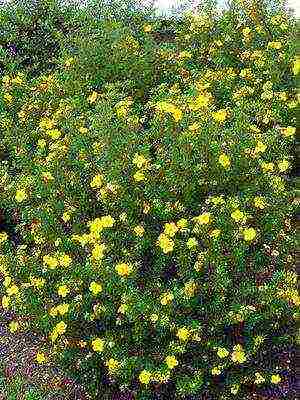
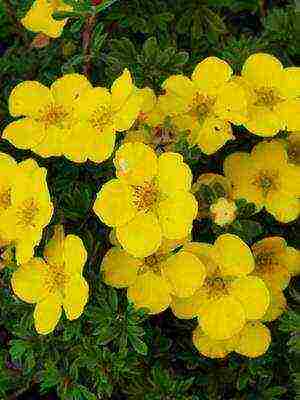
"Goldteppich" ("Goldteppich"). Low dense shrub with strong creeping shoots, its height is 0.5-0.7 m, crown diameter is up to 1 m. Flowers are large, golden yellow, about 4 cm in diameter, bright. Blooms from May to October.
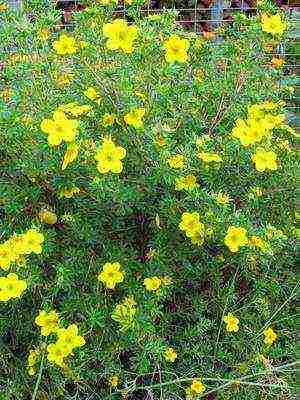
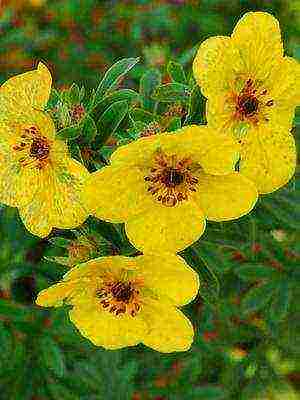
Goldfinger ("Goldfinger"). Dense shrub up to 1 m tall. The flowers are dark yellow, up to 5 cm in diameter. Abundantly flowering.


"Darts Golddigger" ("Dart's Golddigger"). Height up to 0.5 m, crown diameter up to 1 m. The crown is dense, cushion-shaped. It is decorative primarily due to its abundant and long flowering. Blooms from June to October. The flowers are numerous, golden yellow, up to 5 cm in diameter.
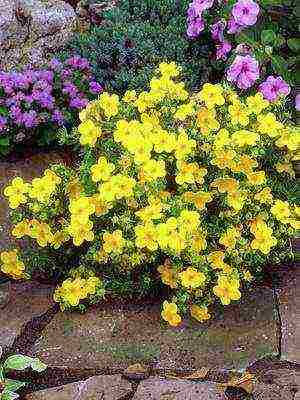
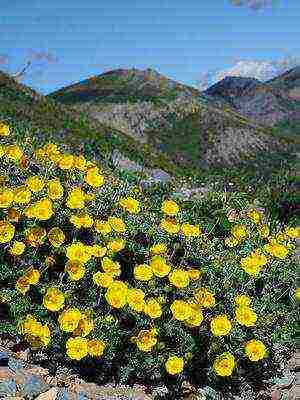
"Elizabeth" ("Elizabeth"). Height up to 0.8 m, crown diameter up to 1.2 m. The crown is dense, cushion-shaped. Blooms from June to October. Flowers are light 2PHOTO yellow, up to 4 cm in diameter.


Red Ace ("Red Ace"). Dense shrub with gentle creeping shoots, 0.5-0.65 cm high, crown diameter 120 cm. The first spring flowers are orange-red, orange-yellow in summer, of medium size (3.5 cm). Blooms from June to September, sometimes until October.
In addition to those listed, among plant lovers, varieties are popular:
- Primrose Beauty, Kobold
- Kobold Hopley Orange and Hopley Orange
- Pink Queen, Goldstern.
Growing Kuril tea: planting and care
Landing features. The distance between plants is 60-80 cm.The depth of the planting pit is 50-60 cm.The root system is shallow, but individual roots penetrate to a depth of 80 cm. The root collar is at ground level. For successful care, planting Kuril tea is recommended to be done in open sunny areas. In the shade, it stops blooming. Does not tolerate soil compaction, demanding of soil fertility.
Top dressing. In the spring and at landing, Kemira Universal is brought in from the Calculation of 2 matchboxes. When growing Kuril tea, before flowering, the culture is fed with superphosphate and potassium nitrate, 1 tablespoon per plant.
Pruning. You can cut the shoots once every 3-4 years in the second half of April by 8-10 cm to make the bush compact.
Preparing for winter. In severe winters, the ends of annual shoots freeze slightly. They are cut off. Plants do not lose their decorative effect, since flowers are formed on the shoots of the current year. Adult plants hibernate under the snow without shelter. Varieties with red and orange flowers are less hardy.
Kuril shrub tea (Pentaphylloides fruticosa) is most common in landscaping. It is a low, up to 1.5 m tall, shrub with a beautiful dense crown and small feathery pubescent leaves.
Differs in long (from June to mid-autumn) flowering. Simple yellow flowers, similar to the flowers of cinquefoil, look spectacular. There are varieties with larger flowers of a different color. But they are less hardy. Kuril tea is undemanding to soil, drought-resistant, winter-hardy. It does not require special pruning, while it easily transfers haircut and rejuvenation "on the stump". It is convenient to propagate it by summer cuttings.
There are many varieties of Kuril tea with yellow flowers. All are good. But if you're looking for variety, look at Abbotswood with white flowers, Princess with pink flowers and Red Ace with red flowers.
What ordinary Kuril tea looks like, look at the photo below:
Description and application of Kuril tea
Kuril tea (five-leafed shrub) is a specimen well-known for its medicinal and decorative qualities. The people also use other names - "Potentilla goose", "mighty".
If we talk about the description of Kuril tea, then we can distinguish several characteristic features of this representative of the plant world:
- It is an upright, highly branched shrub belonging to the Rosaceae family. Height depends on the variety, place of growth.
- The leaves have a complex shape (each element consists of 5-7 miniature leaves), covered with fluffy hairs.
- Flowers of the most common variety are rich yellow. In their center there are about 3 dozen stamens, which give pomp to the inflorescences. There are also specimens with pink, white, scarlet buds. Flowering is long lasting almost all summer.
- Bushes bear fruit in small nuts.
Kuril tea is a shrub that is actively used in the decoration of household plots. Landscape designers use it as monoforms or as part of intricate group compositions. It is effective in low living fences, rock gardens, looks advantageous both against the background of a green lawn and on stones.
Five-leafed leaf does not differ much from ordinary tea in taste, therefore, a fragrant, tonic drink is often prepared from it. It perfectly quenches thirst, activates physical and mental activity.
The cultivation of Kuril tea is important for alternative medicine - it can boast of the richest composition. The plant contains flavonoids, tannin, catechin, saponins. There is a whole range of useful microelements (Ca, Mg, K, Fe, etc.), vitamins C, P, as well as essential oils and resins. Indications for use may be:
- pathologies of the digestive organs - alimentary poisoning, dysentery, dysbiosis, constipation;
- gynecological, hematological diseases - uterine hemorrhages, anemia;
- metabolic disorders, endocrine ailments - diabetes, obesity;
- neurological and mental disorders - neurosis, insomnia, depression;
- dermatological pathologies - ulcers, abscesses;
- inflammatory processes of the oral cavity, throat - stomatitis, tonsillitis.
The immunostimulating activity of smoking tea has been proven, therefore it is advisable to take it during epidemics of influenza, ARVI. Infusions, decoctions (for oral use), lotions (for external application) are made from the plant.
Despite all the positive properties of such tea, not everyone can drink it and not always. Among the contraindications, it is worth mentioning infancy, pregnancy, allergies, serious kidney problems, hypotension, etc. Before using, you should consult with a phytotherapist, be sure to discuss with him acceptable treatment options, the possibility of using a particular variety.
Kuril tea varieties: photos and description of shrubs
Many varieties of Kuril tea are cultivated, each of which has its own characteristics. Collectors, designers and garden enthusiasts prefer the following samples:
Kuril tea "Snowbird"
Bushes 0.7 m high, with a crown diameter of 1 m. The leaves are pale green. The flowers are large (3-4 cm), white with a creamy shade. Flowering begins in mid-summer and lasts until September.
Kuril tea "Abbotswood"
Neat specimens up to 0.75 m high. Flowers are very decorative, numerous, snow-white. Long bloom - from the second half of summer to early autumn.
Kuril tea "Pink Queen"
Height up to 0.8 m, diameter 1.5 m. Blooms from June to September. The color of the buds is all shades of pink. The plant is characterized by frost resistance.
Kuril tea "Tangerine"
Very beautiful, medium-sized bush. The inflorescences are distinguished by a rich bronze-yellow color.
Kuril tea "Klondike"
Early flowering (May-August) bushes 1 m high, 1.3 m in diameter. In early spring, light green leaves bloom, which then turn dark green. Very winter hardy specimen.
Most of the varieties were bred in England, the Netherlands, Ireland - in the course of complex breeding.
After reading the description of Kuril tea, look at the photos of its varieties:
Breeding methods for Kuril tea
In order for the plant to perform decorative functions and could be a high-quality medicinal raw material, it is necessary to ensure the cultivation and care of Kuril tea in accordance with all the rules. Breeding a five-leafed leaf involves several traditional methods. The simplest is grafting. Gardeners like to use this method, because it is not associated with intricate techniques, it is suitable for large-scale reproduction.
Two types of shoots are harvested - how to grow Kuril tea with their help is explained further:
- green cuttings - no more than 2 days should pass between the time of cutting and planting. The length of the shoot with leaf nodes is from 9 to 12 cm. The lower leaves are eliminated, the upper ones are cut in half. Treatment with drugs that stimulate root formation is shown. The material is planted in a prepared, drained substrate, under a film or glass.
- lignified cuttings - mature, leafless shoots harvested in autumn, winter or spring are used. Cuttings tolerate long-term storage and transportation well. The length of the shoot is from 5 to 12 cm. They are planted in a greenhouse.
It will be useful for beginner gardeners to know how to plant Kuril tea with seeds. The grains are harvested in August-September, they are sown in the greenhouse. Seeds are placed in the soil superficially, without deepening, only sprinkling a little on top with a substrate. The risen seedlings are protected from the bright sun, gently tempered. The seedlings are transferred to the "free" soil only after 3 years.
You can reproduce Kuril tea by layering - horizontal or vertical. In the spring, the shoot is pinched with a wire at the very base, shallow notches are made for more successful rooting. The branch is bent to the soil, fixed with a metal bracket, sprinkled with soil, spud.
The division of mature bushes is another elementary and effective technology with which Kuril tea is bred. Planting in this way is allowed when there is access to an adult, 5-6-year-old bush. It is his root apparatus that is divided into several full-fledged sections and then planted in the holes. As a result of manipulation, from 2 to 6 new copies are obtained.
Planting shrub Kuril tea
If we talk about the middle climatic zone of the country, then the optimal shrubs for Kuril tea are planting in a permanent place in the second half of April or in autumn. It is important to approach with responsibility when choosing a place. The cinquefoil prefers bright, sunny areas of the site and rich soil.
The dimensions of the planting ditch are 50x50x50 cm, the distance between the bushes is 60 cm. Lime gravel can become the drainage. The bottom of the pit is filled with humus, sand, turf soil in a ratio of 2: 1: 2. The addition of wood ash, lime, mineral fertilizer is allowed. The best period of the day is considered earlier in the morning or in the evening. The root collar of the plant is not buried excessively, it is left at the level of the edges of the trench.
How to care for Kuril tea and how to prune a shrub
When the planting of smoking tea has been carried out, rational care is required - the success of the plant survival depends on it. The near-trunk territory is mulched with hay or peat. In dry season, the young bush is supplied with water daily, for 2-3 weeks.
Some stages of planting Kuril tea and caring for it in the future, look at the photo:
Gardeners really like such an unpretentious plant as shrub Kuril tea - planting and caring for it does not imply difficulties and professional skills.
Pay attention to the following points:
- Top dressing. The first application of mineral fertilizers is carried out during transplantation of a bush from a greenhouse container to a permanent place. Plants that have not yet taken root completely are not recommended to be very actively fed. During the period of intensive growth and flowering, mineral fertilizing with a predominance of phosphorus and potassium will be appropriate. Nitrogen-containing preparations are good in the spring, but are contraindicated in the fall.
- Watering. Although drought tolerance is one of the advantages of Shrub Shrub tea, caring for it does not exclude the need to water this plant. During the season, several irrigations are required (10 liters of water under one bush), followed by mulching the soil around the trunk. If the summer is too hot, then the crown is additionally sprayed.
- Pruning. It is important to know how to cut Kuril tea so that it fully fulfills the decorative tasks on the site. Bushes are cut in cloudy weather, in the late afternoon. Shoots are shortened by 8-12 cm, get rid of all dry and diseased branches. A shaping haircut is performed to keep the crown tidy throughout the summer season.
Cinquefoil is almost not susceptible to common diseases or pest aggression. Occasionally it is affected by rust. In such a situation, it would be advisable to use 2% sulfur.
A mature plant hibernates safely under the snow, without shelter. In very frosty winters, the tops of young shoots can freeze slightly. Kuril tea is refreshed by pruning - branches affected by the cold are simply cut off in the spring. This does not negatively affect flowering as it occurs on the shoots of the current season. It is advisable to cover bushes of the 1st year of life with mulch for the winter.
The cinquefoil will add zest to your favorite garden, provide incredibly valuable supplies of medicinal material. Kuril tea does not require complex or specific care, which attracts close attention of gardeners, arouses sympathy from connoisseurs of the original design of sites.
There is an interesting pattern: the wider the distribution area of a plant, the more names it has. In our case, the original name was "Dasiphora", from the Greek word
"Dasys" - means thick-haired and "phoros", which means "carrying", that is, bearing thick hairs or simply "fluffy". Such are the leaves and shoots at a young age in this shrub.
A little later it was nicknamed "Pentaphylloides", apparently because of the leaves, pinnate, consisting mainly of five leaves. Pointed, glossy in the upper part and glaucous below, they slightly resemble the spread-out paws of birds, hence another name - Potentilla. Not to be confused with erect cinquefoil or galangal, which is a herbaceous perennial!
We know this shrub as Kuril tea. Obviously, the name came from the Kuriles, where the locals prepared a rather tart drink from the selected leaves, reminiscent of green tea.
Kuril tea
The genus contains 10 species, all widespread in nature, found in the Far East, and in Japan, and in China, as well as in Europe and North America, in Asia. Kuril tea can be found in floodplain meadows, river banks, forests, rocky outcrops and rocky valleys. Unpretentiousness and vitality, plus high decorative qualities (abundant and long flowering, neat bush shape) have long attracted the attention of ubiquitous gardeners. Having looked at several promising species, among which were the five-leafed Daurian (P. davurica), Manchurian (P. mandshurica) and shrub (P. fruticosa), the breeders settled their eyes on the latter. Five-leafed shrub, he also shrub cinquefoil reaches a height of 1.5 meters, has dense shoots, a rounded crown, silky pubescent leaves and golden flowers, similar to the spray of the sun.
Kuril tea varieties
On the basis of Shrub Potentilla, a large number of wonderful varieties with flowers of various colors were bred.
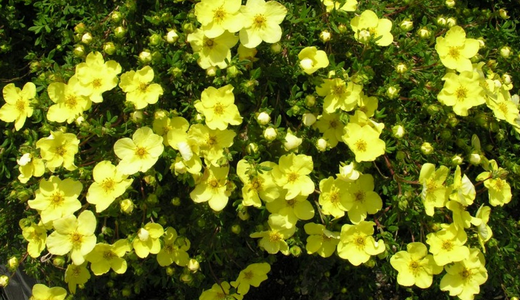 So, a group with yellow flowers is made up of varieties:
So, a group with yellow flowers is made up of varieties:
— Goldfinger (blooms profusely from June to October and has a high winter hardiness);
— "Goldstar" (large flowers up to 5 cm in diameter);
- compact "Kobold" (height 60 - 80 cm);
— "Klondike" has the earliest flowering (blooms in May, blooms until August);
— "Primrose Beauty" with a spherical crown and bluish-green pubescent leaves. The group with white and cream color includes:
The group with white and cream color includes:
— Abbotswood (numerous milky white flowers plus beautiful light green leaves);
— Eastlay Cream (needs shelter for the winter);
— "Vilmoriniana" and "William Purdom" (tall bushes with a grayish foliage).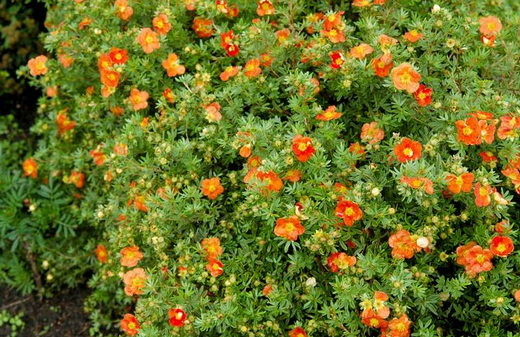 And finally, the most interesting varieties with pink, red and orange flowers. Among them:
And finally, the most interesting varieties with pink, red and orange flowers. Among them:
- fabulous "Red Ice" - undersized shrub with orange - red flowers (may turn pale in the bright sun);
— Hopleys Orange with bright orange;
— "Sunset" with transitions from orange to red on one bush;
— "Tangerine" - with copper flowers (retains color better with a little shading). - They differ in pink palette: delicate "Pink Quinn", "Floppy Disk" with semi-double flowers; "Pritty Polly" with pale pink shades; "Princess" - pink flowers with yellow eyes.
- They differ in pink palette: delicate "Pink Quinn", "Floppy Disk" with semi-double flowers; "Pritty Polly" with pale pink shades; "Princess" - pink flowers with yellow eyes.
Kuril tea, cultivation, care, reproduction
It should be noted that Potentilla with yellow-colored flowers turned out to be the most winter-hardy. It is advisable to cover the rest for the winter with spruce branches, foliage or non-woven material.
In general, Kuril tea is not difficult to grow. The plant is unpretentious, grows well on any soil, except for heavy clayey, excessively moist. Prefers sun and light partial shade. It does not need watering, except that in a drought it can be watered 3-4 times per season. Pests and diseases are rare for Kuril tea. Perfectly lends itself to annual haircuts, which are recommended to be done in autumn (in September) or in spring (in April).
Kuril tea is propagated by seeds (with 3-month stratification) or vegetatively: lignified and green cuttings, dividing the bush and layering.Kuril tea bushes tolerate transplanting well at a young age, adult bushes will take root badly.
Kuril tea in garden design
It is a versatile shrub that can be used solo or in groups, as curbs and dense carpets (creeping shoot varieties such as Hackmann Giant, Tilford Cream). It will not be superfluous in the mixborder in the company of perennials and low bushes with a contrasting leaf blade shape. It is also used for decorating slopes and rocky hills.
If your garden needs a reliable, beautiful and time-tested unpretentious shrub, choose Kuril tea - with minimal effort, it will delight you for a long time with abundant flowering and unusual shades of foliage.
All information about ornamental shrubs can be found in a special section on our website here.
The hedge of Kuril tea turns out, though not high, but dense and very beautiful throughout the summer.
Kuril Princess tea stands out with a dense cushion-shaped crown and pink flowers.
One of the best varieties of Kuril tea is Abbotswood. The plant has a dense pillow-shaped crown, light green leaves and white flowers up to 2.5 cm in diameter.
Flowering bushes of Kuril tea are good in any bright corner of the garden. Pictured is a Goldtepech hybrid. The diameter of the flower is about 4 cm. The plant is resistant to powdery mildew.
Decorative form of Kuril tea Pretty Poly. The diameter of the flower is about 3.5 cm. The shrub has thin, broadly spreading shoots.
Golden yellow large flowers of the Sommerflor hybrid. Blossom from June to the end of September.
The Red Ace variety is very dressed up at full bloom.
‹
›
Kuril tea blooms in the gardens until late autumn. This plant was named so because in Siberia, Kamchatka and the Kuriles, its dried leaves and flowers are used as a healing tonic drink. Brew at the rate of 1 tbsp. a spoonful of crushed raw materials for 250 ml of boiling water, honey is added and insisted for 30 minutes. Another name for Kuril tea is five-leaf tea - according to the structure of the leaf, which consists of five leaves. Kuril tea has another name - Dasiphora (daziphora), which translated from Greek means “bearing thick hairs”. And among the people, Kuril tea is often called cinquefoil - for the shape of the leaves.
In nature, this plant can be found in the Caucasus, Siberia, the Far East, in the mountains of Central Asia, Mongolia, China, Japan, North America, and Western Europe. It grows along river banks, in floodplain meadows, in the undergrowth of mountain forests, on rocks and stony slopes, high in the mountains up to the alpine belt. About 10 species of this plant are known. All deciduous, highly branching shrubs 0.9-1.5 m high. Young shoots are pubescent, adults are covered with grayish-brown scaly bark. Small feathery leaves are often pubescent on both sides with silky hairs. Large flowers of various shades of yellow that adorn the plant in summer are collected in inflorescences located at the ends of the shoots in the form of an umbrella, brush or shield.
The leaves and flowers of Kuril tea contain a lot of ascorbic acid - several times more than in lemons and almost as much as in black currant berries. They even contain carotene, as well as tannin, flavonoids, organic acids, essential oils, and resins.
As a medicinal raw material, one-year flowering tops of shoots 10-15 cm long are used, they are cut with scissors or pruners at the end of July-August, dried in the shade in the open air or in a well-ventilated room.
The high activity of Kuril tea against pathogens of intestinal infections, including Vibrio cholerae, has been experimentally proven. It treats dysbiosis in children, normalizes metabolism, is a diuretic, but at the same time treats bedwetting. In addition, the infusion of Kuril tea relieves constipation, has a beneficial effect on duodenitis, cystitis, and also as a sedative in stress.
The local population uses the infusion of Kuril tea to treat wounds, burns, abscesses, boils, to rinse the mouth and throat for angina, stomatitis and other diseases of the oral cavity.
VARIETY OF VARIETIES
Kuril tea has been grown in the gardens for about 300 years. Most often, there are decorative forms and varieties of Kuril shrub tea, or shrub five-leaf tea. These low-growing plants (from 0.5 to 1.5 m) are most suitable for rocky gardens, rock gardens, hedges and small compositions with perennials, low yews, junipers, thujas. Bushes grow rapidly in breadth. The crown of an adult Kuril tea is dense and shaped like a pillow.
One of the lowest (height - about 0.6 m) is Kobold Kuril tea with light yellow flowers. It grows faster than other varieties, therefore, to maintain the crown in a decorative state, it is recommended to prune it regularly. In early spring, in May, the light yellow flowers of the Jackman variety open up. From June to October, the Goldfinger variety blooms profusely with large (diameter - up to 5 cm) yellow flowers. Almost the same large golden-yellow flowers in the Sommerflor and Goldteppich hybrids. Another long-flowering variety is Goldstar. The height of the shrub is 0.8-1 m, the diameter of the crown is up to 1.2 m. Spectacular dark yellow flowers in the Farreri variety.
Original pink flowers of medium size (diameter - 3.5 cm) in decorative forms Pretty Polly and Princess. Soft creeping shoots and orange-red flowers in the Red Ace cultivar. Very beautiful when fully blooming, the undersized Longacre variety, blooming from June to September. This plant has bluish green leaves and flowers with a yellow center. One of the best is considered the Abbotswood variety with pure white flowers.
The Kuril tea of the Klondike variety is distinguished by its winter hardiness - a shrub with a spreading crown up to 1.3 m in diameter and light yellow flowers.
HOW TO GROW A FLOWERING BUSH
Caring for Kuril tea is not difficult and does not take much time.
Choose an open, sunny place for landing. The plant is not demanding on soil fertility, but does not take root well on too dense soil. It can develop normally on both slightly acidic and calcareous soil.
Bushes are placed at a distance of 60-80 cm from one another. Planting depth - 50-60 cm. Drainage is required, usually a 20-cm layer of broken brick or river pebbles. The roots of this plant are superficial, only some of them penetrate to a depth of 80 cm. The root collar should be at ground level. The pits are covered with a mixture of leafy earth, humus and sand in a ratio of 2: 2: 1. A complete mineral fertilizer is added to the planting mixture (100-150 g per 1 m2). Plantings are watered and mulched 3-5 cm with humus.
The planting time for this unpretentious shrub is both spring and autumn. Seedlings with a closed root system can be planted at any time.
The next year, in the spring, feeding with full mineral fertilizer is repeated. Before flowering, the plant needs phosphorus and potassium.
Kuril tea can go without water for a long time. But in hot and dry summers, it is recommended to water at least three times per season (the norm is 10-12 liters for each bush) and spray in the evening.
To give the bushes compactness, once every 3-4 years, the shoots are shortened: in the second half of April - by 8-10 cm or in September - by a third of the length. The plant easily tolerates haircuts and retains its shape for a long time.
Kuril tea hibernates under the snow without shelter. Only in winters with little snow do the ends of annual shoots freeze - they are cut out in the spring. This does not affect the quality of flowering: the flowers of Kuril tea are formed on the shoots of the current year. With age, as well as due to top dressing, the winter hardiness of plants increases.
Varietal Kuril tea is propagated vegetatively: green and lignified cuttings, layering, root suckers, dividing bushes.When cuttings are cut in June, in the rooting year, plants grow from cuttings 30-35 cm high with a root system 23-27 cm long. Such plants are already suitable for planting in a permanent place in the garden and bloom the next year.
